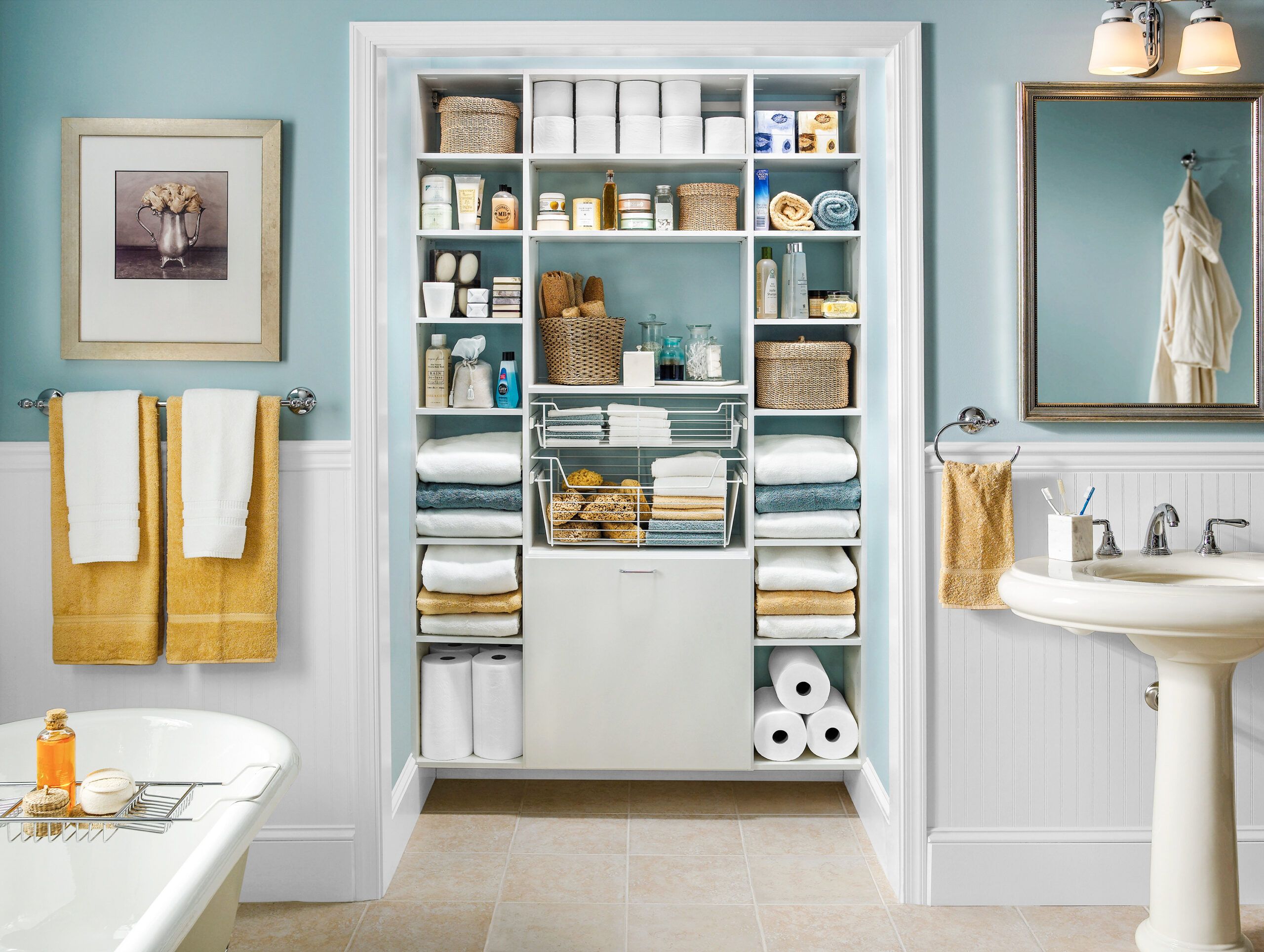We may be compensated if you purchase through links on our website. Our team is committed to delivering honest, objective, and independent reviews on home products and services.
A well-organized closet can make all the difference between feeling flustered in your morning routine and starting your day on the right foot. Whether you have a spacious walk-in with built-in storage or a compact reach-in closet, we’ll teach you how to organize your closet according to your needs.
Walk-In Closets

Walk-in closets are roomy spaces for storing and displaying clothing, accessories, and more. If your closet has enough space, there’s no need for seasonal clothing rotations. But if it isn’t organized properly, it can quickly become a cluttered catch-all space.
Make Some Space
To add a walk-in closet, homeowners often annex an extra bedroom or part of one. To create the one at left, DIYers Michelle and Erik Dagenhart of Charlotte, North Carolina, converted an existing bedroom in their 1922 Craftsman into a master bath and walk-in closet, with a small hallway between the two.
The his-and-hers closet, which is 19 1/2 feet long and 6 1/2 feet deep, features the cabinet at left at its center, on display through the cased opening. Michelle’s side holds four sections of four drawers, topped with a counter and open shelves, and 10 feet of hanging space—Erik’s side holds half as much.
Incorporating Built-In Elements
Built-in elements can make your walk-in closet more cohesive and stylish. The Dagenharts repurposed a salvaged cabinet as a focal point, customizing it with metal screening and building matching side cabinets. The screened “windows” let them see what’s where at a glance, while the closed doors keep things feeling neat and contained. Labeled linen-covered boxes up top house Michelle’s dress shoes and special-occasion gear.
Separating Pieces
Allocate space in a shared walk-in closet based on each partner’s needs. Take inventory of folded items, long-hanging clothing, and short-hanging pieces. Designate specific drawers for tank tops, jeans, underwear, or any item you have a lot of.
Pro organizer Barbara Reich also likes to set up a “Marriage Saver” drawer or cabinet where the partners have permission to be messy. “Make it small and something that closes, so you don’t have to look at it,” she says. “Then you’ve put a limit on how much is appropriate to store.”
Starting Fresh
If you’re moving into a home with an existing walk-in closet, start organizing as you unpack. You can also work with a professional organizer to create an efficient system from the start.
Dressing Closets
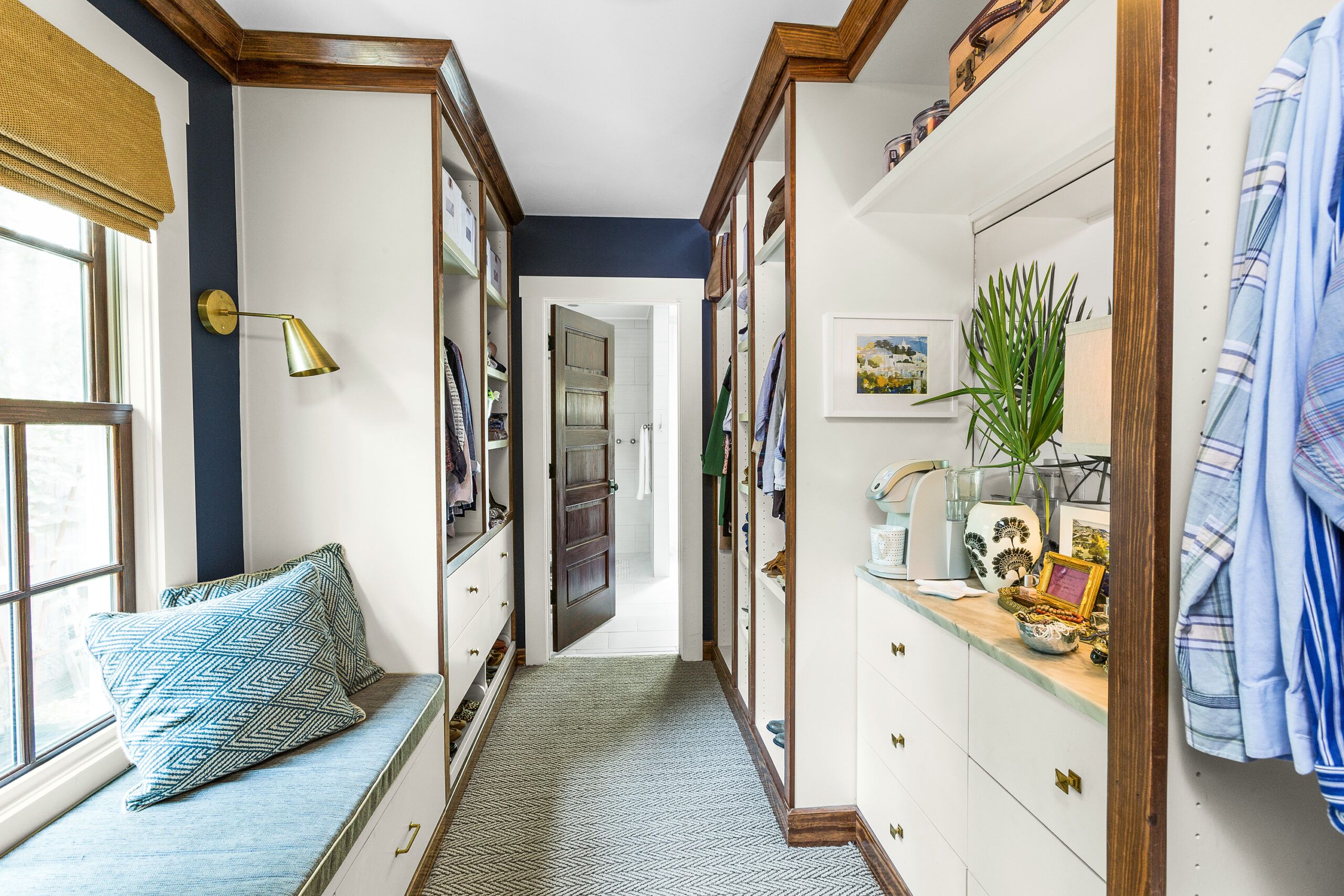
For those who like to take their time getting ready, a dressing closet with seating and a dresser is ideal. Joe and Shelley Pelliccione of Savannah created the closet above—14 feet long and 7 feet 8 inches wide—between their bedroom and bathroom as part of a first-floor expansion.
Fit and Trim
To get a custom, high-end look without breaking the bank, use off-the-shelf closet components and bridge them with decorative trim. Joe, a contractor, had the closet built in sections, which were bridged with 2½-inch-wide stained-wood trim that matches the rest of their 1943 cottage. It’s an idea anyone can borrow using off-the-shelf closet components from stores like The Home Depot and IKEA. “The trim makes it look a lot more expensive than it is,” Shelley says.
Take a Seat
The center of the Pellicciones’ dressing room is geared for lounging. “It’s designed with space to let me relax,” says Shelley. The 5-foot-long window seat has become a favorite spot for her to enjoy morning coffee. As a practical plus, its large drawers hold totes, beach towels, and yoga mats.
Add a Dresser
A chest of drawers makes a closet feel fully furnished and offers a chance to give it some style. The Pellicciones’ dresser, sized at 4 feet wide and only 16 inches deep, came from a store Shelley owned. Joe built it in and topped it with a piece of salvaged marble, installing a mirror and a shelf above it. It even has a countertop spot sectioned off for Shelley’s coffeemaker. In closets where space is limited, a lingerie chest works well.
Using Specialty Storage
Set up towers and dedicated spaces for items you have lots of. “My husband is a prolific T-shirt collector,” says Shelley. “And if I can’t get rid of them, at least I can make them look pretty.” Their clothing storage bays—4½ to 5 feet wide and 2 feet deep on both sides of the window seat and dresser—include a pair of tall, narrow shelving units amid the mix of hanging space, wider shelves, and drawers. His is filled with T-shirts—hers holds purses, dress shoes, and accessories.
Open Wardrobe Closet
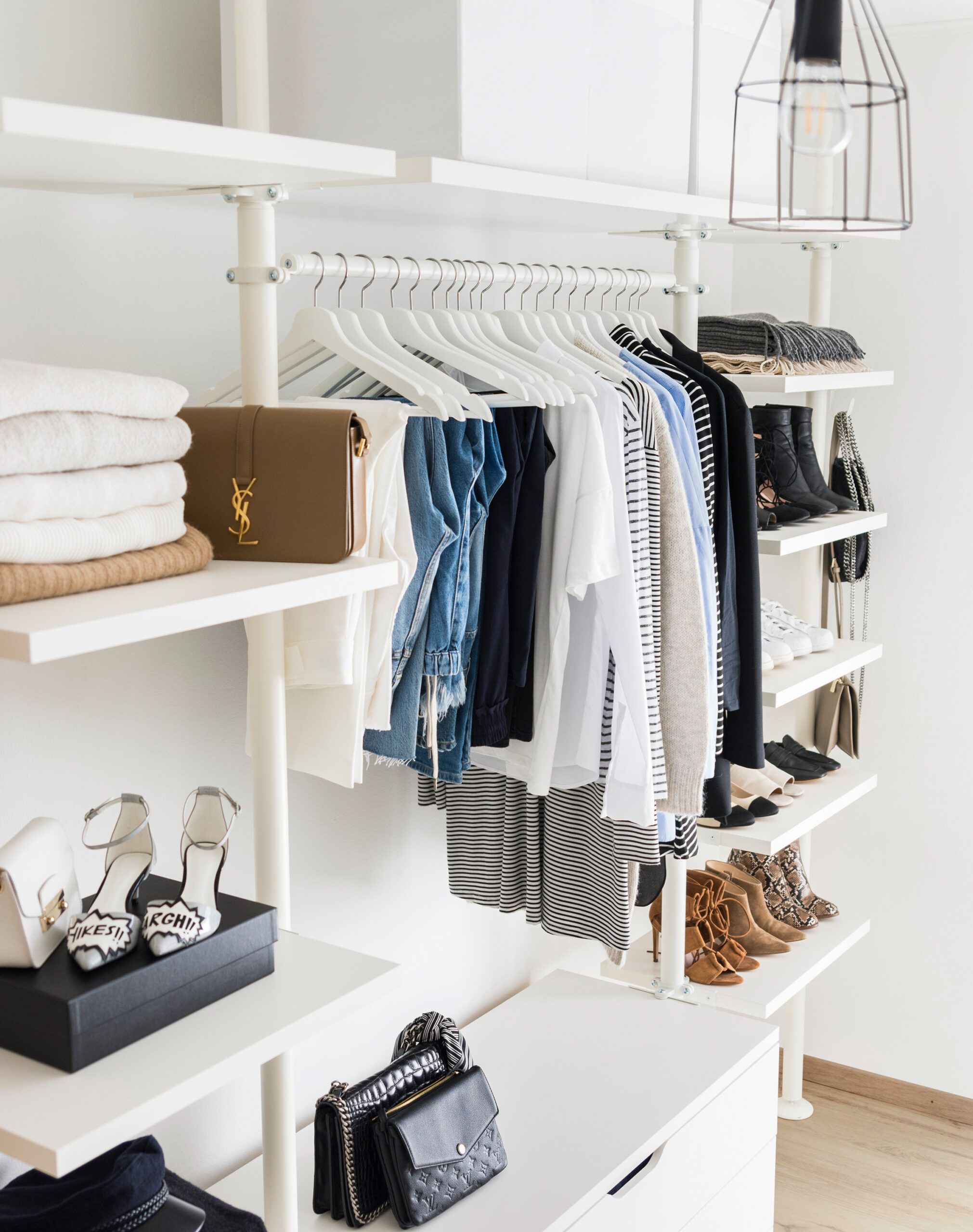
For older homes without closet space, open clothing storage along a bedroom wall or under a sloped ceiling can be ideal.
Plan Your Shelving
Your clothing is on display with an open wardrobe, so you should try to find a system that looks attractive while staying functional. You can purchase a group of modular pieces to assemble or make your own with pipes, shelves, and Speed-Rail fittings.
Store Off-Season Clothes
To keep your open wardrobe looking tidy, store out-of-season clothing in garment bags. Hang them on rolling wardrobe racks in the attic or keep them in boxes under your bed.
Organizing Footwear
Organize your shoes based on how often you use them. “Store shoes you wear often out in the open, where you can grab them,” says Sarah Buckwalter of Organizing Boston. “Shoes you wear occasionally should go in clear plastic bins.”
Saving Space
Maximize your hanging space with clever organizers. For example, you can use multi-tier swing arm trouser racks to store multiple pairs of pants on one hanger. You can also store small purses and accessories in repurposed clear acrylic file sorters.
Double Reach-In Closets
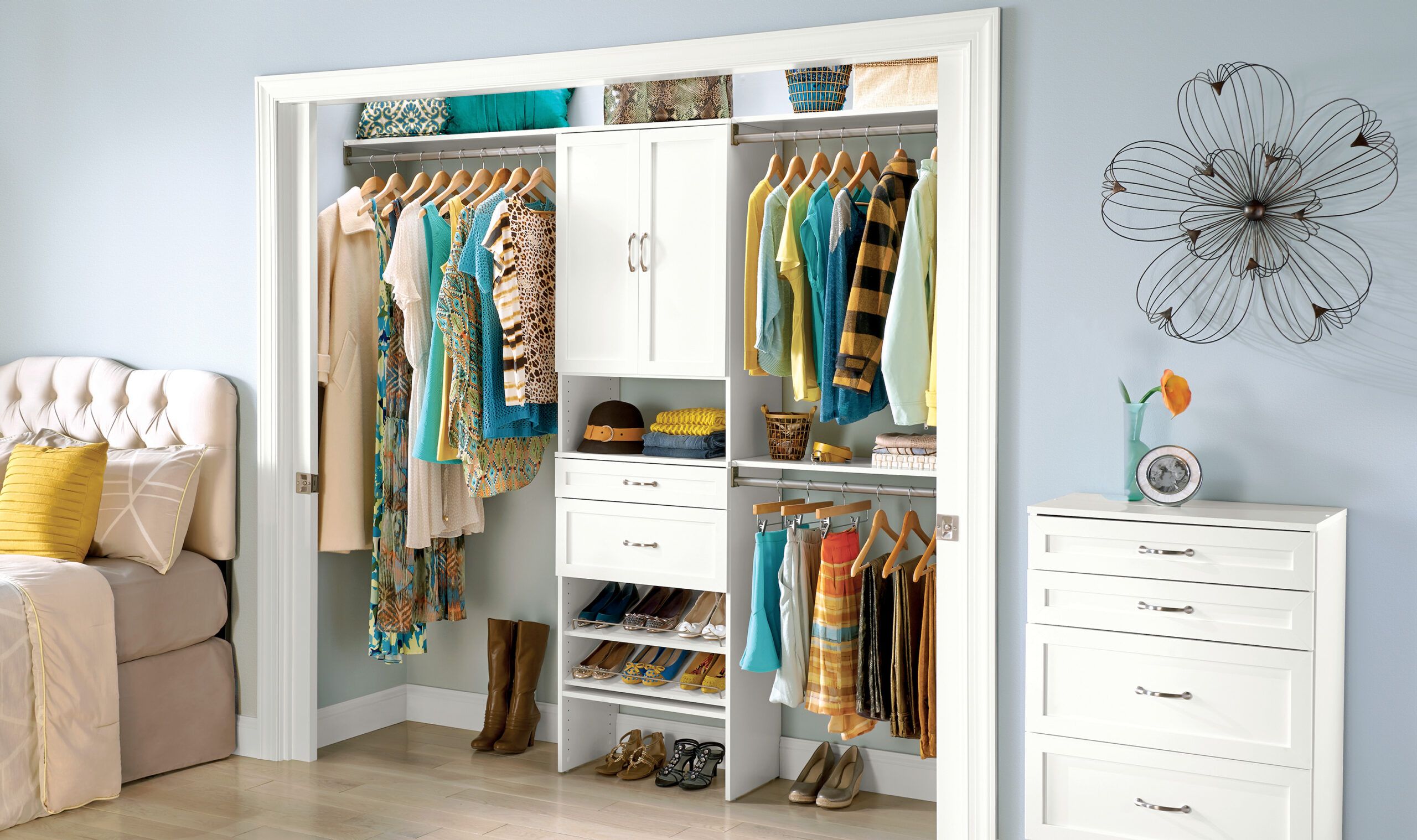
“Double-door reach-in closets give you access to everything, and that’s an optimal closet to me,” says Houston organizing pro, Ellen Delap. Because they’re just one hanger deep, nothing gets hidden in the back. An ideal setup has shelves and drawers in the center, with long hanging clothes on one side and two rods for short hanging on the other.
Going Modular
Affordable, modular closet components can help speed up your organizer planning and building. As you plan, be sure to account for baseboards and electrical outlets.
Using Hangars
Use only one type of hanger throughout your closet to create a cohesive look. Slim velvet-covered hangers look sleek and can save up to 30% of hanging space compared to bulkier alternatives.
Compartmentalize Your Clothes
Use drawers to organize smaller items like lingerie, socks, and swimwear. Keep them tidy with adjustable drawer dividers, and add some decorative liner paper for a touch of style. Grouping similar items in specific drawers helps keep everything orderly and accessible.
Craft Closets
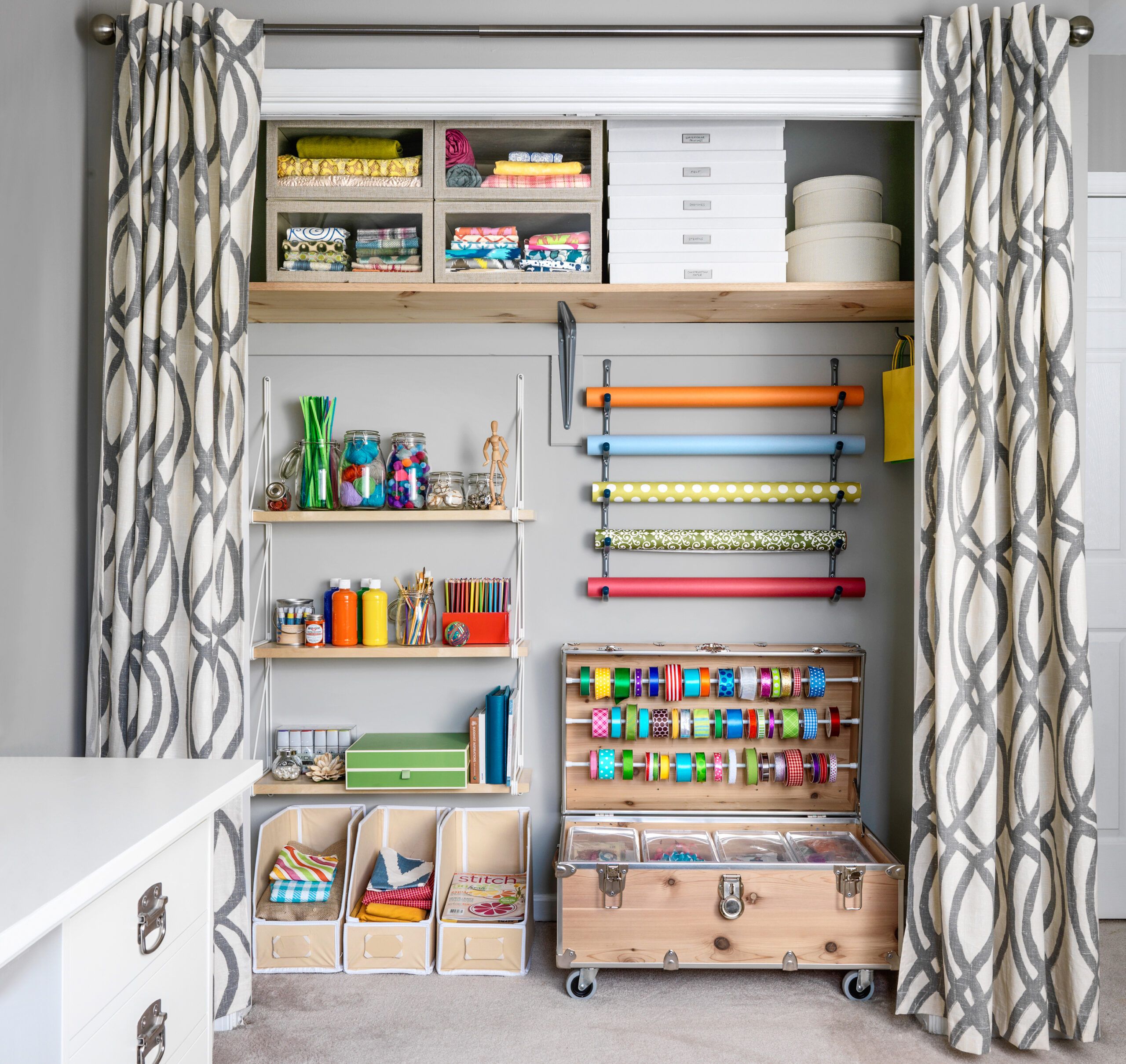
Hobby closets often keep small parts and pieces that need specialized storage solutions.
Tidying Up
Swing-out double doors let you view everything at once. Buckwalter likes clear containers and lots of narrow shelves for beads or paints. Delap also suggests curtains to hide craft supplies. “It’s a softer look,” she says, “and they make it easy to get into the closet.” They’re also a good solution where bypass or bifold doors hinder full access.
Use Mobile Storage
Mobile storage can make your hobby cabinet more flexible with time. If you get a trunk-on-wheels, it can serve as both storage and a work surface. You can also mount rods inside the lid to hold ribbon rolls or magazine butlers to store fabric remnants.
Think Small
Invest in storage systems designed for small items. These containers often have adjustable components, nesting capabilities, and flip-over tops that can double as trays.
Keep Items Handy
The way you organize containers can help you focus more on crafting and less on finding materials. Store supplies you use the most at a convenient eye or shoulder-level height. Clear labeling and transparent containers can also save you time.
Utility Closets
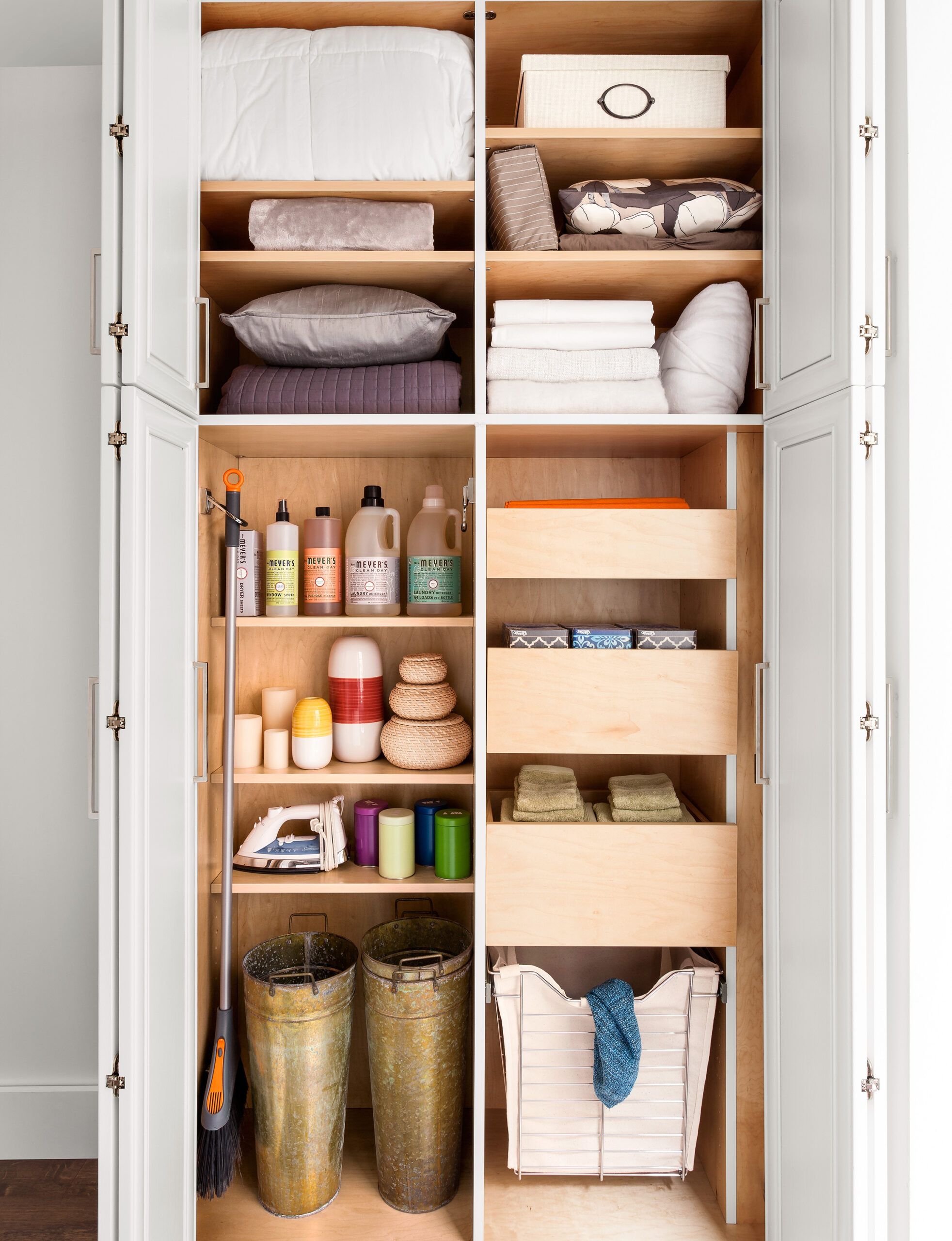
An everything-in-its-place approach to household and cleaning supplies can be a major time-saver on chore days.
Use Drawers
For deep shelves, add pull-out drawers on glides to help you reach tall and heavy items near the back. That way, you won’t have to remove everything in front of them.
Get Hooked on Hooks
Maximize vertical space by hanging mops, brooms, and other cleaning tools. Wall-mounted organizers can keep your floor space clear by confining the hooks to a small, narrow space.
Using Baskets and Shelves
Sliding chrome baskets can help you store dirty linens until laundry day. Use your upper shelves for bulky items like extra towels and pillows. Don’t forget to include a folding step stool for easy access to high storage areas.
Linen and Bathroom Closets
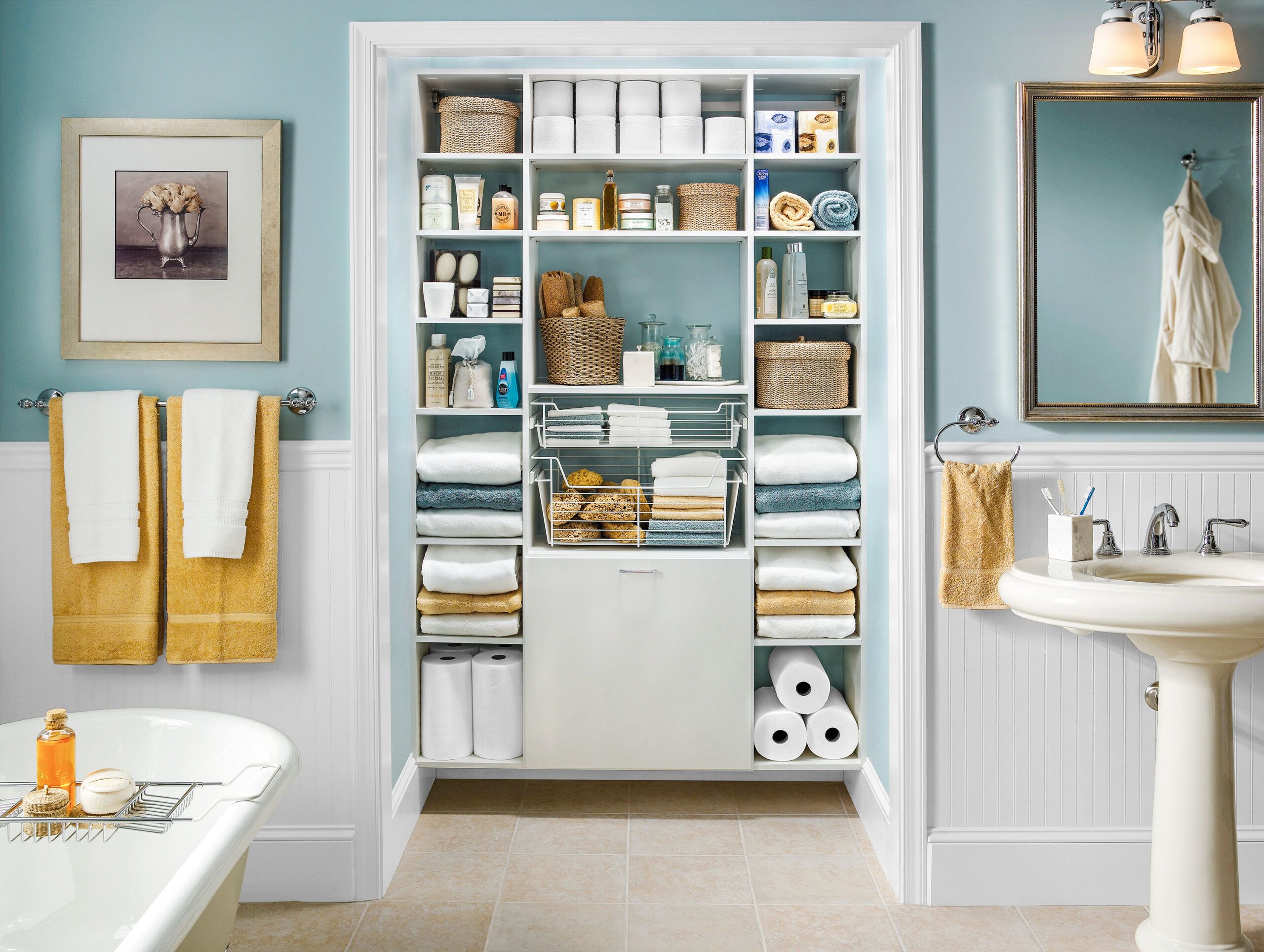
Depending on your home’s layout, your entire family may use a single linen closet, which can get really messy, really fast.
Take stock of sheets, towels, and other items that need a home here. Be sure you’re not holding on to old “backup” towels and pillowcases you never really use.
Group Like Items
Designate specific shelves to towels and sheets. Group towels by their purpose and group sheet sets by bed size. Label each shelf category for easy identification. Roll towels instead of folding them so you can grab one without disturbing the entire stack.
Divide and Conquer
Some linen closets have wide shelves instead of divided ones. In that case, add dividers to keep your stacks upright, or swap some for slide-out wire bins.
Know Where to Put Things
Put toiletries in baskets or clear boxes and place them at eye level. High shelves are just the right perch for all those rolls of toilet paper and boxes of tissues you stock up on at the warehouse store. A tilt-out hamper below holds used towels until you have time to do the laundry.
Use Labels Effectively
Let everyone know what’s kept where. Be specific when grouping products, with labels such as Hair, Teeth, Soap, Lotion, and Sunblock. Stacked clear bins maximize storage space. Use a small lazy Susan to store little jars and bottles so they don’t end up in a jumble.
Closets By the Numbers
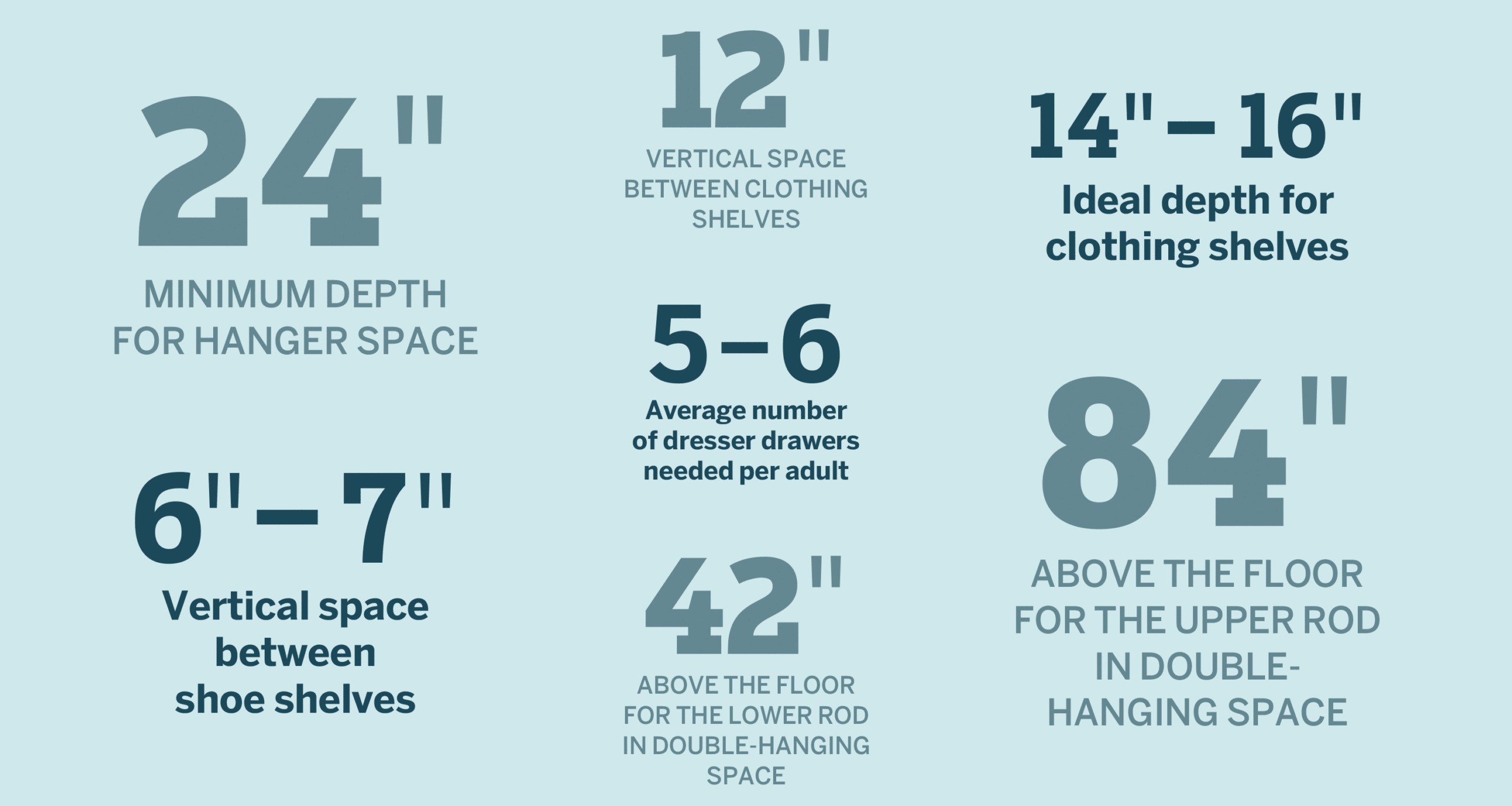
Tricks of the Trade
Professional organizers and closet designers have extensive experience with various storage products. Here are four items considered indispensable for effective closet organization:
- Over-the-door shoe organizer: In a coat or entry closet, use one with clear plastic pockets to store sunscreen, bug repellent, mittens, and scarves. They’re perfect for organizing scrapbooking supplies in a craft room and toiletries and small bathroom appliances in a small linen closet.
- Slat wall system: Slat wall panels are popular in garages and shallow closets. If you only have hanging space on one side of the closet, install a slat wall on the other side. Use hooks to hang purses, scarves, and jewelry.
- Drop-front shoe boxes: These fabric-covered boxes with a see-through end panel and drop-down front make shoe storage more convenient. The window lets you quickly identify the shoes you need, while the drop-front design eliminates the need to rearrange boxes to get to the shoes you want.
- Valet rod: Attach a valet rod to a vertical support in your closet for instant extra hanging space. These tools are particularly useful when packing for a trip, hanging dry cleaning still in plastic, or holding items waiting to be ironed.
Thanks to: Sarah Baldwin, Faire Evoluer; Sarah Buckwalter, Organizing Boston; Ellen Delap, certified professional organizer; Samantha Hochman, TransFORM; Barbara Reich, professional organizer and owner of Resourceful Consultants; Scott Davis, vice president of product development and marketing, ClosetMaid.
